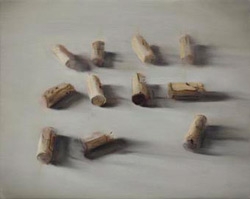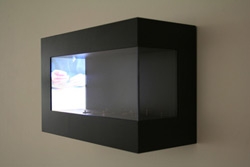A world of ‘quiet mystery’
Text: Uchida Shinichi
Portrait: Nagare Satoshi
If there were such an activity as creating quietness, then Michaël Borremans’ paintings could well serve as a model. The figures in his paintings, which are depicted with a fineness bordering on hardheadedness using a palette based on beautiful dark hues, seem either to be devoted to some private ritual, or repeating – albeit unknown to themselves – some endless activity, as if a spell has suddenly been cast on them in the midst of their daily routines. Who are they and what stories are they living? It was this world, a world of what could be described as ‘quiet mystery’, that was revealed to visitors to Earthlight Room, Borremans’ first solo exhibition Japan.
“It’s not important who they are or what they’re doing exactly. They’re more universal, symbolic metaphors. I paint various kinds of people, but in each case they’re important not as portraits of particular people but as general ‘human beings’. I depict the act of doing, or creating. Just as many artists have done in the past, I’ve adopted the format of portrait painting for my work. But what I paint aren’t ‘portraits’ as such. I’m simply using that format.”

Fixture, 2008
Oil on canvas, 40 x 50 cm
Certainly, the manner in which these anonymous individuals and their mysterious actions are depicted in an atmosphere that at times calls to mind 19th century portraits is striking.
“All artists are influenced by works from the past. However, it’s a question of reflecting rather than respecting, and of recuperation. Bruce Nauman is grounded in the past, but he’s also contemporary. The Gallery of Horyuji Treasures (editor’s note: designed by Taniguchi Yoshio), which I visited the other day, is also very old and universal, but at the same time contemporary. Good artists don’t just destroy the past; they’re also able to develop it in various directions, into something aggressive and innovative.”
The important thing is how the viewer responds to the work; this, according to Borremans, is what fascinates him the most. Speaking of which, it was fascinating to see a lone still life among the portraits in this exhibition.

Commutation, 2008
Oil on canvas, 40 x 50 cm
“I placed the corks in the same room where I place my human models with the same lights. For this show, for the first time all the paintings are painted with all the subjects placed in the same room under the same lights. That’s why it’s called Earthlight Room. I tried to paint the humans like objects, and the objects like humans, and tried to see the result. So it’s also an experiment. I will continue to do this for my next show, too, I think, and perhaps even more in the future. But when works become too conceptual, there’s no place any more for the imagination. That’s not what I want to do.”
Many of Borremans’ drawings, which the artist has exhibited from an early stage in his career, reflect a more surreal worldview. One of these, which almost resembles a sketch for a stage design, has also been displayed in the form of a scale model (The German).

The German, 2004-07
Scale model, mixed media, 35 mm film transferred to DVD
“A lot of my drawings are proposals for paintings or installations. You say they remind you of stage design, but I’m not interested in whether they’re realized on the stage or not. I like the world of the imagination, and in a sense you can say something’s already been realized once someone has imagined it. Each viewer can view it however they like. In the same way that there is a writer and a reader. A work is complete only when there has been this collaboration between both parties.”
The exhibition also included a number of film works, which Borremans began to incorporate into his shows several years ago. However, as far as the artist is concerned, these, too, are ‘paintings’.
“What I do in film, it’s painting, really. I present it like painting. You don’t have to watch it from beginning to end. You can walk by it if you want. What I don’t want to do is have people go into a dark room, and you have to watch it and it’s very boring. I also want to make it beautiful. I’m not afraid to use beauty.”
One of these films, The Field, consists of languid shots of a young woman whose body abruptly turns into a flat surface resembling a table from the waist down (a painting with the same motif was also displayed). There’s an almost sculptural quality to the figure, which turns its body while staring into space with eyes that appear to be drained of all emotion.
“I tried to depict it as if it’s a moving sculpture. But it’s just an image, and an image is like a ghost. It’s not physically there. Once I did try to make a sculpture like in this film, and it was too real, too physical. It didn’t correspond to the picture in my head.”
Finally, I asked Borremans if all the traveling to different cities around the world that’s resulted from the steady increase in his popularity as an artist has also affected his creative activities.

The Feeding, 2006
35 mm film transferred to DVD
All images © Michael Borremans
Courtesy Zeno X Gallery, Antwerp and Gallery Koyanagi
“There’s probably some influence. But that reminds me – although it’s not really an influence – of something that occurred to me the other day. As with all the works in this show, The Feeding was created with no reference whatsoever to Japanese culture, yet I was surprised after coming to Japan to discover that the scene inside the kitchen of a tempura restaurant resembled very closely the scene in this work. It’s incredible, isn’t it? With regard to becoming busy and that affecting my work… I don’t want to work for a show. Contemporary artists who are successful today have a show here and a show there and they have to tell people all kinds of things, like the kind of works they’ll show and the titles of the works. When I think about that I cannot work. I like to work without being dominated by anything.”
Fitting words from an artist whose paintings manage to draw out such an abundant world from ‘quietness’.
2009.1.27

Michaël Borremans
Born 1963 Geraardsbergen, Belgium. Lives and works in Ghent. He has been showing internationally since the 1990s, and had is first solo museum exhibition of drawings in 2004. His first solo show in Japan, Earthlight Room, was held at Gallery Koyanagi in 2008.
